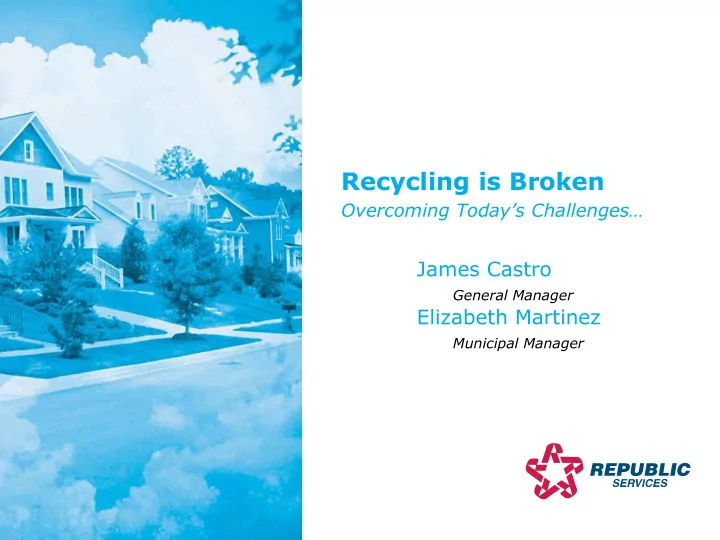

Recycling is Broken Overcoming Today’s Challenges… James Castro General Manager Elizabeth Martinez Municipal Manager
The Recycling Life Cycle Factors Driving Costs Participation rates – • Higher participation, while the goal, drives more costs Pounds per set-out – • plays a significant role in service cost per household Commodity mix – • changes in the stream can impact processing costs Residual/contamination – • drives additional direct costs Commodity value – direct • impact on any returns 2
Trends in Markets Glass has negative • value in most markets, unless supported by subsidies Corrugated • Cardboard has decreased in price per ton for last 5 years End markets • impacted by global slow-downs 3
Trends in Material Trends Implications Material no longer in circulation 18M tons in 2000 → ~2M in 2015 Lighter-weight and limited end markets HDPE → off-spec PET Lighter-weight and flexible packaging not recyclable Tin can → copolymer pouch Waste minimization increasing pressure on total waste and recycling tons 4
China Sword Explained For decades, China has been the largest importer of the world’s recycled commodity, and the U.S. was 40% of the inbound stream. In 2017, China announced efforts to clean up the country, which included dramatic changes for acceptance criteria of imported recyclables. A significant reduction in acceptable • contamination levels (From ~3% to 0.5%) in any recovered paper and plastic grades. Additionally, China banned all mixed • paper from import, regardless of contamination levels. (20% of historical stream). Reductions took effect in March 2018, and drive costs and changes at most recycling facilities in the country to meet new standards 5
Market Impacts of China Sword 6
China Sword Immediate Impacts Adjusted processing speeds to • improve quality of sorted material − As a result, some facilities are unable to handle daily material volume Adding human resources to our sort • lines, and increasing self-inspections to further reduce contamination Exploring investments in newer, more • accurate sorting technology (in select Jan 2018 – Processed bales in Northwest, without market buyers, deteriorated by weather markets) Actively exploring other domestic and international markets • − Many are flooded by the global industry shifting away from China While we continue to process mixed paper and old newsprint, we are proactively evaluating the need to dispose of excess material that deteriorates beyond the point of commercial value, or poses safety risks 7
New Recycling Business Model The Cost of Recycling Commodity Collection Processing Residual Sales • Cost to provide truck, • Capital & labor • Contaminated or non- • Processed material driver, container and intensive process recyclable material transported and sold scheduled collection to end markets service on contracted • Comingled material • No marketability basis sorted into separate • Subject to quality products, removing standards • Must be transported • Collected material contamination and disposed at transported to landfill for a cost • Product mix and processing facility • Clean products baled quality drives value and prepared to ship • Some material may have negative value + Monthly Collection Net Processing Fee Charge (Commodity sales – processing costs – residual cost) The cost of a recycling collection program is the sum of the Collection Charge and the Net Processing Fee 8
Long Term - Public Education 1. Public Education – WHAT to Recycle ALWAYS NEVER Recyclable SOMETIMES Recyclable Recyclable Shoes/ Diapers Garden (Select Markets) Clothing Hoses Paper Plastic Plastic Bags Glass Food Metal Cardboard Yard Waste Waste 2. Public Education – HOW to Recycle Empty. Remove any remaining food or liquid contents from your recyclable item before placing it in a recycling container; Clean. Lightly rinse the recyclable item to remove any remaining residue; and Dry. Gently shake out excess water or let the recyclable item air dry before placing it in a recycling container. 9
Recommend
More recommend